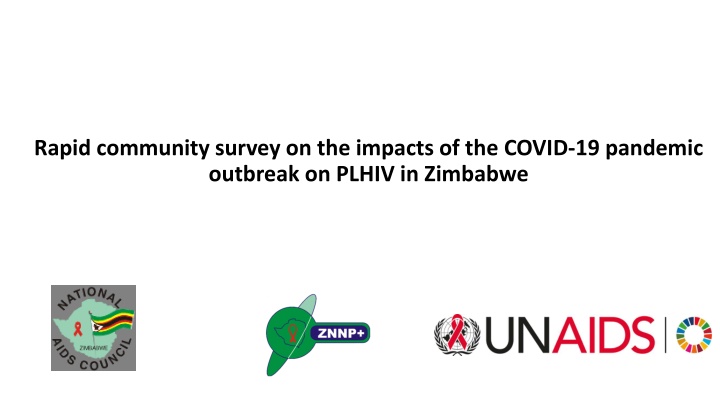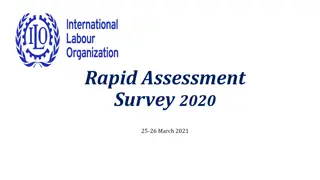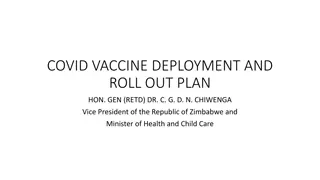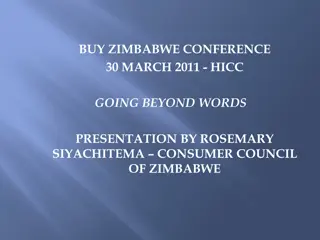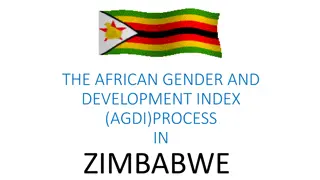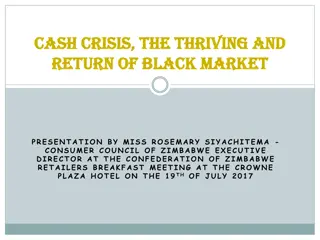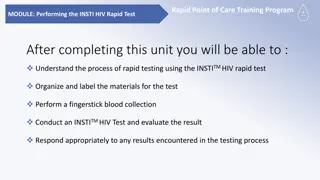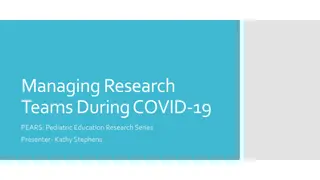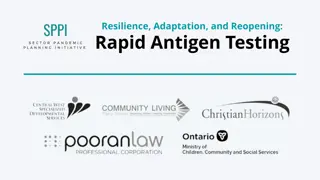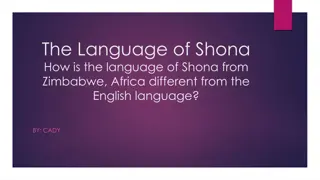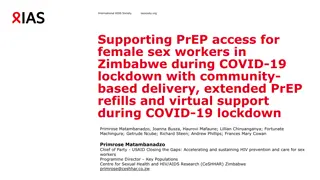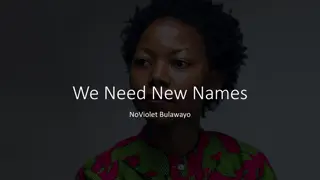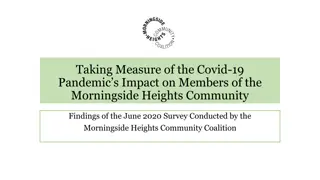Rapid Community Survey on COVID-19 Impact on PLHIV in Zimbabwe
This rapid community survey in Zimbabwe assessed the impact of the COVID-19 pandemic on people living with HIV (PLHIV). Conducted online through platforms like SurveyMonkey and WhatsApp, the survey focused on access to preventative materials, HIV treatment, information on COVID-19 prevention, and psychosocial support. Results showed a significant response rate, mainly from urban areas, highlighting the challenges faced by PLHIV during the pandemic.
Uploaded on Sep 22, 2024 | 1 Views
Download Presentation

Please find below an Image/Link to download the presentation.
The content on the website is provided AS IS for your information and personal use only. It may not be sold, licensed, or shared on other websites without obtaining consent from the author.If you encounter any issues during the download, it is possible that the publisher has removed the file from their server.
You are allowed to download the files provided on this website for personal or commercial use, subject to the condition that they are used lawfully. All files are the property of their respective owners.
The content on the website is provided AS IS for your information and personal use only. It may not be sold, licensed, or shared on other websites without obtaining consent from the author.
E N D
Presentation Transcript
Rapid community survey on the impacts of the COVID-19 pandemic outbreak on PLHIV in Zimbabwe
Context Survey objectives Outline Results Recommendations
The context A pneumonia of unknown cause detected in Wuhan, China was first reported on 31 December 2019 As at 19 April 2020, more than 2.4 million confirmed cases globally COVID-19 and HIV Patients with severe immunodeficiency usually have high risk of complications with any infectious disease
Undertake a rapid assessment of impacts of the COVID-19 pandemic outbreak on people living with HIV (PLHIV) in Zimbabwe Survey Survey objectives objectives Specific areas of inquiry: Access to preventative materials against COVID-19 for PLHIV & their families Access to HIV treatment for PLHIV (and other essential HIV services e.g. MMD) Availability of Information on COVID-19 prevention information Access to psychosocial support during the outbreak
Online national anonymous survey: Distributed by ZNNP+ and NAC To increase reach, dual approach: SurveyMonkey and WhatsApp Survey Survey Duration: 1 week, 3rdto 9thApril 2020 Approach Approach Criteria of Survey Participants: 18 years old; People Living with HIV Limitations: Time-bound quick evaluation Online survey unable to cover population with limited internet access
Results Results
Respondents Respondents A total of 158 PLHIV responded More than 2/3 of responses via WhatsApp survey platform Majority (78%) of respondents classify the area in which they live as urban National COVID-19 pandemic map as of 14/04/2020
Gender and Age distribution of respondents Age Gender
Types of phones and household HIV burden Phone type PLHIV on ARV treatment for HIV in household
Respondents experience with refilling ARV prescription in the last week
1 = 0 Approximate days of medication for children 2 = 1 1 = 60 1 = 180
Main challenge in getting ARV treatment on time during the COVID-19 epidemic Travel distance 1% Fear of exposure to coronavirus 1% There is no transport to go to the facilities because buses are not working 1% I am not experiencing any challenges in getting my ARV treatment 1% My usual pharmacy is closed or has limited hours 5% Stockouts 7% Family illness 8% I have been told that police is beating up people in the city centre 14% Health workers attitude 18% I had already refilled 20% Cost of medicines 23% 0% 5% 10% 15% 20% 25%
Reasons why respondents who did not get refills dont know where to go to get their medications 3%3% 3% Because I am from another country where I usually access medications 31% Because I am not in the part of the country where I usually access medications Because the clinic or support group where I access medications is not functioning I am not sure if travel is possible 60% It's because I don't have transport money
High levels of anxiety Level of anxiousness regarding COVID-19 Average score = 3.65 Level of anxiousness on scale (1 to 5) from not anxious to extremely anxious, where 1 is not anxious and 5 is extremely anxious
Respondents concerns about COVID-19 Concern for my own health 31% Concern about family members health 19% My ability to get medications 18% Isolation 14% Stigma related to HIV status 7% I cannot work on the streets 4% I will not get the help and security of my daily living because I am disabled and 2% Because PLHIV are said to be more vulnerable to the virus 1% Family members finding out I am taking ARVs 1% My eternal life 1% 0% 5% 10% 15% 20% 25% 30% 35%
Respondents ability to access measures to prevent exposure to COVID-19 Adequate amounts of soap or hand sensitizer 35% Clean water 29% Tissues 15% Separate space where I live from people who are ill or are diagnosed with COVID-19 9% Others 7% Masks 4% 0% 5% 10% 15% 20% 25% 30% 35% 40%
Barriers to respondents efforts for self-isolation I need to provide care for family or friends 40% I need to go to work 30% I need to access medical care or medications 25% I do not have a stable place to live 3% Fear of dying or getting sick alone 3% 0% 5% 10% 15% 20% 25% 30% 35% 40% 45%
Respondents access to other key services Psychosocial support 55% 5% 40% Contraceptives 60% 23% 18% Condoms 43% 15% 43% Tuberculosis treatment 23% 28% 50% 0% 20% 40% 60% 80% 100% 120% No Not needed Yes
Access to physical support for daily living functions for Access to physical support for daily living functions for respondents living with a disability respondents living with a disability 45% 55% Yes No
Other necessary health services that respondents are not able to access right now None 46% OI treatment 15% Condoms 7% Contraceptives 7% Nutritional support 4% Viral load test 4% Chest x-ray 2% Counseling 2% Glasses for my eyes 2% Not able to attend school 2% Pregnancy test 2% SRHR education and services through Adolescents Art club refill groups . 2% STI screening and treatment. 2% Support Group meeting 2% 0% 5% 10% 15% 20% 25% 30% 35% 40% 45% 50%
Services that are critical for respondents to adhere to HIV treatment during this crisis 30% 27% 25% 25% 20% 16% 15% 13% 9% 9% 10% 5% 0% A way to get my HIV medications safely; Family counseling to provide accurate information to family members about HIVn 1; Counseling for anxiety, depression, or other conditions; A way to confidentially take my medications in private; Family counseling to provide accurate information to family members about HIVn 1; Peer support/connection with other people living with HIV;
Respondents knowledge of an organization that they can reach out to for information and support at this time 17.50% 82.50% Yes No
Specific health need that needs attention at this time Rheumatoid athritis treatment 3% Pregnancy test 3% Nutritional support 3% Eye glasses 3% Diabetes 3% Chest pains 3% Persistent headache 5% Mental Health (stress) 8% ART refill 20% None 53% 0% 10% 20% 30% 40% 50% 60%
Other key information Other key information
Need follow-up? Granted permission to share contact info with authorities 40% 60% Yes No
Situation room and call centre for PLWHIV Outreach services for MMD refill of ARVs and consultation on OIs Short to medium-term recommendations Referral pathways for psychosocial support Remove user fees for health services to assure universal access to publicly- financed essential health services
